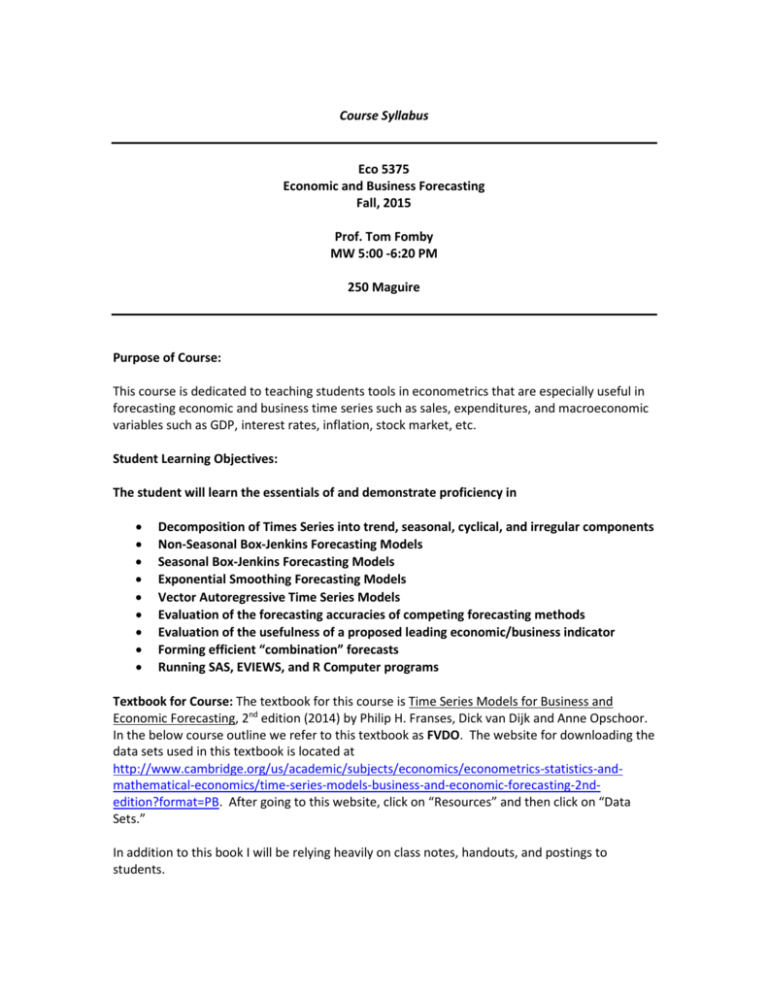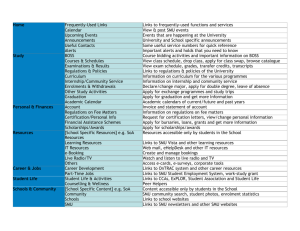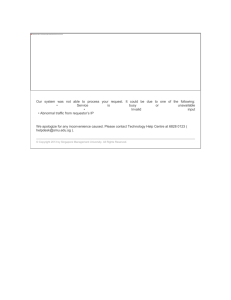Course Syllabus Eco 5375 Economic and Business Forecasting Fall
advertisement

Course Syllabus Eco 5375 Economic and Business Forecasting Fall, 2015 Prof. Tom Fomby MW 5:00 -6:20 PM 250 Maguire Purpose of Course: This course is dedicated to teaching students tools in econometrics that are especially useful in forecasting economic and business time series such as sales, expenditures, and macroeconomic variables such as GDP, interest rates, inflation, stock market, etc. Student Learning Objectives: The student will learn the essentials of and demonstrate proficiency in • • • • • • • • • Decomposition of Times Series into trend, seasonal, cyclical, and irregular components Non-Seasonal Box-Jenkins Forecasting Models Seasonal Box-Jenkins Forecasting Models Exponential Smoothing Forecasting Models Vector Autoregressive Time Series Models Evaluation of the forecasting accuracies of competing forecasting methods Evaluation of the usefulness of a proposed leading economic/business indicator Forming efficient “combination” forecasts Running SAS, EVIEWS, and R Computer programs Textbook for Course: The textbook for this course is Time Series Models for Business and Economic Forecasting, 2nd edition (2014) by Philip H. Franses, Dick van Dijk and Anne Opschoor. In the below course outline we refer to this textbook as FVDO. The website for downloading the data sets used in this textbook is located at http://www.cambridge.org/us/academic/subjects/economics/econometrics-statistics-andmathematical-economics/time-series-models-business-and-economic-forecasting-2ndedition?format=PB. After going to this website, click on “Resources” and then click on “Data Sets.” In addition to this book I will be relying heavily on class notes, handouts, and postings to students. Certification in SAS: If you are an Applied Masters student in our department you might want to consider becoming certified in SAS. There are two levels of certification: Level I - SAS Certified Base programmer (http://support.sas.com/certify/creds/bp.html) and Level II – SAS Certified Advanced Programmer (http://support.sas.com/certify/creds/ap.html). If you take and pass either of these tests, the Richard B. Johnson Center for Economic Studies will cover the costs of the exam (approximately $90). Having a SAS certification on your resume can help you find a job in quantitatively oriented fields. All SMU students have access to free e-learning courses for the purpose of preparing for the certification tests. If you are interested in accessing these free e-learning courses, just let me know and I will provide more information to you. Accessing Computer Software for this course: The University is downsizing its computer labs and is instead encouraging the use of statistical and mathematical software via Apps.smu, a virtual computer environment accessible from your personal PC or laptop. We will primarily be using SAS (Statistical Analysis System) produced by the SAS Institute located in Cary, North Carolina although we may occasionally use the EVIEWS (Econometric Views) software package that is also available on Apps.smu. To access SAS and EVIEWS on Apps.smu you first have to download Citrix Receiver to your PC or laptop. To do this, go to http://apps.smu.edu. As a first time user of Apps.smu, you will be directed to download Citrix Receiver on your PC or laptop computer. After you have done that you will see the Apps.smu canvas. Then drag to the canvas the apps you need for this course (SAS 9.4 and EVIEWS). You should be ready to go for your homework assignments. Evaluation of Student: The evaluation in the class consists of four parts: • Quick Quizzes (20%) • Exercises (20%) • Mid-Term Exam (30%) • Final Exam (30%) The Quick Quizzes (QQs) will consist of a short answer and/or multiple-choice quiz that will be administered in the first five minutes of the class. The QQs are designed to see if you have retained the information of the previous lecture and if you have done any assigned readings that I may have asked you to do. In addition to keeping the students current in the class and providing review material for the mid-term and final exams, the QQs allow me to keep track of student attendance. Given the fast pace of a summer course, it pays to attend each and every class meeting! To reflect the fact that not every day is a good day, I will be dropping your lowest QQ grade before calculating a QQ average. With respect to homework exercises, students can confer with each other on programming advice and discussion of basic ideas but in the final analysis each student is expected to write up his/her own homework answers and not make copies of others’ homework. Copying someone else’s homework to hand in as one’s own work is a violation of the SMU Honor Code and will be dealt with according to the rules of the SMU Honor Code. Homework assignments are very important in that the basic ideas covered by them invariably show up on the mid-term and final exams. If you know you are going to be missing a class on the day a homework exercise is due, hand in your homework in advance to receive full credit for your work. Any homework that is 2 handed in late will be given a one letter grade reduction for each day of tardiness. It is my policy to drop your lowest exercise score before calculating your exercise average. Students will be excused from taking the mid-term exam or the final exam only with a note from a physician, or in the case of a death in the family, with a note from a parent or guardian. Even with an excused absence, either of these exams must eventually be taken before a course grade will be assigned to the student. If you must miss a class due to legitimate circumstances beyond your control, be sure and contact me beforehand so that I will know of your circumstances. If excused, I will correspondingly excuse you from any QQ that is given that day. I want to emphasize that diligent attendance in this course is essential because a lot of the course material presented in class will be from my personal class notes and can’t be found in any textbook per se. Note: After 4 unexcused class absences, I reserve the right to administratively drop students from the class. My grading scale in this course is as follows: A: 92-100; A-: 90-91; B+: 88-89; B: 82-87; B-: 80-81;C+: 78-79; C: 72-77; C-: 70-71; D+: 68-69; D: 62-67; D-: 60-61; F: 0-59. Classroom Website: http://faculty.smu.edu/tfomby/ Office: Room 301M, Umphrey Lee, 214-768-2559. E-mail address: tfomby@smu.edu. Office Hours: 1:00 – 2:00 pm MW or by appointment. My Graduate Teaching Assistant: Igor Zhadan. His E-mail address is: izhadan@smu.edu If you should need extra tutorials or help outside of my office hours, contact Mr. Zhadan and he will be happy to help you. Important Dates to Remember: First Day of Class: Monday, August 24. Labor Day Holiday: Monday, September 7 Fall Break: Monday – Tuesday, October 12-13 Last Day to Drop a Class: Friday, November 6 No Classes on Wednesday, November 25 Thanksgiving Break: Thursday – Friday, November 26-27 Last Day of Class: Monday, December 7 Final Exam Date: Monday, December 14, 3:00 – 6:00 pm in Room 250 Maguire General comments on work and class etiquette: In order to succeed in this class, constant work is essential. Come to class. Read all assigned readings and prepare for the Quick Quizzes. Don’t get behind. If there is something in class discussion or homework assignments that you don’t understand, don’t hesitate to ask me in class, after class, during office hours, or through e-mail. 3 Obviously, general rules of etiquette apply: cell phones are to be turned off during class and miscellaneous reading material stowed away. I expect you not to be surfing the web except for econometric concepts while I am in full lecture. Some Standard Items You Should Know Excused Absences for University Extracurricular Activities: Excused Absences for University Extracurricular Activities: Students participating in an officially sanctioned, scheduled University extracurricular activity should be given the opportunity to make up class assignments or other graded assignments missed as a result of their participation. It is the responsibility of the student to make arrangements with the instructor prior to any missed scheduled examination or other missed assignment for making up the work. (University Undergraduate Catalogue) Disability Accommodations: Disability Accommodations: Students needing academic accommodations for a disability must first contact Disability Accommodations & Success Strategies (DASS) at 214-768-1470 or www.smu.edu/alec/dass.asp to verify the disability and to establish eligibility for accommodations. They should then schedule an appointment with the professor to make appropriate arrangements. (See University Policy No. 2.4) Religious Observance: Religious Observance: Religiously observant students wishing to be absent on religious holidays that require missing class should notify their professors in writing at the beginning of the semester, and should discuss with them, in advance, acceptable ways of making up any work missed because of the absence. (See University Policy No. 1.9.) Honor Code: All SMU students are bound by the Honor Code (see SMU Student Handbook for a complete discussion of the SMU Honor Code). The code states that “any giving or receiving of aid on academic work submitted for evaluation, without the express consent of the instructor, or the toleration of such action shall constitute a breach of the Honor Code.” A violation can result in an “F” for the course and an Honor Code Violation on your transcript. 4 TOPICS I. Introduction to Course A. Focus of this Course: Time Series Forecasting B. Field of Forecasting is meeting the “Market Test” C. Key Features of Economic Time Series References: Chapters 1 and 2 in FVDO. Reference: Class Notes. II. A Brief Introduction to SAS A. APPS.SMU and Accessing Computer Programs on SMU’s Virtual Server – Downloading Citrix Receiver B. Introduction to SAS (SAS = Statistical Analysis System) i. Program Editor in SAS 9.4 ii. Data Steps and Procedure Steps iii. Log and Listing Files C. Inputting Data i. Direct Input ii. Infile and set statements Reference: Class Notes. III. Preparing Time Series Data for Forecasting A. Proc Expand in SAS B. Interpolating Missing Observations C. Changing the Frequency from Monthly to Quarterly D. Changing the Frequency from Quarterly to Monthly E. Transforming the Data Reference: Example 8 in Forecasting Examples (class handout) IV. Additive Decomposition of Time Series A. Y = T + S + C + I (Additive Decomposition) B. Trend, Seasonal, Cycle, Irregular Components C. A Stylized Decomposition of a Time Series D. It is important to know which components are in your time series and to properly account for them. Otherwise, you will sacrifice forecasting accuracy. Reference: Class Notes 5 V. Box Jenkins Models for Stationary, Non-Seasonal Time Series A. Some Simple Box-Jenkins Models and Their Properties i. ARMA(0,0) ii. MA(1) iii. AR(1) iv. ARMA(1,1) v. General Notation vi. Concepts of Stationarity and Invertibility B. Identification Tools i. Autocorrelation Function (ACF) ii. Partial Autocorrelation Function (PACF) C. Pattern Table D. Sample Statistics E. Information Criteria F. P/Q Box G. Overfitting Exercises H. Example: Lead Production Data References: Chapter 3 in FVDO and Class Notes. VI. Box-Jenkins Models – Forecasting for Stationary, Non-Seasonal Time Series A. Minimum MSE Forecasting B. Various Forecast Profiles C. Example: The Forecast Profile and Confidence Intervals for the Lead Production Data Reference: Chapter 3 in FVDO MID-TERM EXAM Wednesday, October 7 VII. The Modeling of Trend A. Stochastic Trend: The Random Walk Model B. Deterministic Trend C. Contrasting Prediction Intervals for these different types of trends References: Chapter 4 in FVDO and Class Notes VIII. Box-Jenkins Models for Non-Seasonal, Stochastically-Trending Time Series A. Taking the First Difference to Control for Stochastic Trends B. Taking, On Occasion, Second Differences of the Data C. Augmented Dickey-Fuller Tests for Unit Roots: To Difference or Not To Difference? D. Example: The growth rate of Real GDP E. Log Transformation and How to Use it F. How to Forecast with Logged Data Reference: Chapter 4 in FVDO 6 IX. Statistical Tests for Seasonality A. Buys-Ballot Plots B. Autocorrelations at Seasonal Lags C. Friedman’s Non-Parametric Test of Seasonality References: Chapter 5 in FVDO and Class Notes. X. Seasonal Box-Jenkins Models A. Simple Additive Seasonal Models B. The Multiplicative Class of Box-Jenkins Models C. The ACFs and PACFs of Multiplicative Seasonal Models E. Example: Airline Passenger Data F. Testing for Seasonal Differencing References: Chapter 5 in FVDO and Class Notes. XII. Exponential Smoothing – An Old Favorite (Proc Forecast) A. Simple Exponential Smoothing (No Trend, No Seasonality) B. Double (Brown) Exponential Smoothing (Trend, No Seasonality) C. Additive Seasonal Exponential Smoothing (No Trend, Seasonality) D. Winters Additive Method (Trend, Seasonality) E. Plano Sales Tax Revenue Data – An experiment showing the importance of Determining the presence or absence of trend in your time series data Reference: Class Notes. XIII. Searching for an Extra Variable to Help Us Forecast: VARs (Proc VARMAX) A. Be careful: The Spurious Regression Problem B. The Equal-Lag Length Vector Autoregressive Model C. System-Wide Goodness of Fit Measures to Help Choose the Lag-Length D. Using Out-of-Sample Forecasting Experiments to Detect Useful “Extra” Variables for use in Forecasting a Variable of Interest E. Diebold-Mariano Test for Significant Differences in Forecasting Accuracies F. Example: The “Series M” Data Set References: Chapter 3, pp. 71 – 74 and Chapter 9 in FVDO and Class Notes Xiv. Combining Forecasts A. Combination Forecasting i. Some Basic Theorems on Diversification of Forecasts ii. Nelson Combination Method iii. Granger-Ramanathan Combination Method iv. Combinations with Time-Varying Weights B. Application to Economic Time Series Reference: Class Notes. 7 TIME PERMITTING: XIV. Regime Switching Time Series Models A. Threshold Autoregressive (TAR) models i. Self-exciting TAR model ii. Exogenous Variable TAR model B. Smooth Transition Autoregressive (STAR) models C. Markov Switching (MSW) models D. Tests for Nonlinearity in Time Series Reference: Chapter 8 in FVDO. XV. Market-Based Forecasts A. Interest Rate Forecasts based on the Term Structure B. Inflation Forecasts based on TIPS Breakeven Rate C. Futures Market Forecasts Reference: Class Notes FINAL EXAM Monday, December 14, 3:00 – 6:00 pm in Maguire 250 END OF COURSE 8





